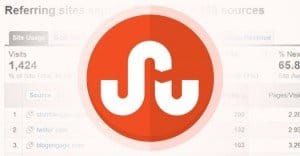Is StumbleUpon Traffic Too Low Quality to Consider?

StumbleUpon is one of those names in SEO that comes up now and then with virtually no explanation. It’s usually tacked on to the end of a list of social networks to use to build traffic, generally when the author is trying to avoid the Standard Five of Facebook, Twitter, Google+, Pinterest and Instagram. With so little elaboration, however, is it even worth considering? What is StumbleUpon, how does it compare and can you use it for your own benefit?
What is StumbleUpon?
Founded in 2002, StumbleUpon was a fairly innovative idea. Users would register for the site and fill out a profile. The bulk of this profile is a massive list of interest categories, ranging from art and architecture to TV shows and even pornography. Once they had their profile interests saved, they would download a toolbar and install it in their web browser.
The toolbar has a few features, but the primary use is the stumble button. Clicking that button would query the StumbleUpon databases for a website categorized in one of the user’s interest categories. One click might take the user to a review of a renaissance painter, while the next could bring them to a video on CollegeHumor.
On each site, a user is given the chance to thumbs up or thumbs down a page, as well as leave a written review. This information goes back to the Stumble servers, which serve up websites with higher ratings in preference over sites with little interaction. Additionally, any page the user reviewed or thumbsed up is added to that user’s feed, which ties into the disused social network aspect of the site.
Essentially, StumbleUpon played on the inherent lack of attention span notable in most Internet users. Bored of the current article? Click stumble and find something new.
Great Traffic Potential
In 2010, StumbleUpon claimed to have ten million users. It’s a far cry from the 150 million on Instagram or the 1.2 billion on Facebook, but that was four years ago. Two years ago they had 25 million users. Unfortunately, use of the site declined. The company went through a rocky period with eBay buying the company, and the investors later buying it back, along with site redesigns that drove away users.
This is the same period where many SEO writers and marketers began picking up Stumble as a marketing tool. With millions of users visiting billions of sites every year, it was a massive source of traffic. Perhaps the best description comes from the Verge; it’s a big dumb firehose of traffic.
The problem, as outlined in that Verge article, is the quality of that traffic.
The Problem With StumbleUpon Traffic
StumbleUpon peaked years ago, and has been on a decline. Even during its peak, however, the quality of the traffic coming from the toolbar was low. You could have the potential to see thousands or millions of users visiting your site in an extremely short period, particularly if you received an influx of positive reviews and thumbs ups.
The problem with stumble user quality is similar to the problem with unfocused ads on Facebook; many of the users who visit just don’t care about your content. They may read a blog post, they may click a thumb up or down, and they’ll take off as easily as they arrived. Very, very rarely would they stick around to click through your site. Using stumble was the objective, not finding new sites to read.
Adding Paid Discovery
StumbleUpon, just like any other online business, needs to find a way to monetize itself. Like Facebook and other sites, Stumble chose paid promotion. The idea was to pay to give yourself a bit of a boost in visibility, which would attract thumbs ups and reviews, which boost your organic visibility until you don’t need to pay to sustain higher traffic.
In practice, of course, the traffic you received was just as disengaged as it ever was and you would have to pay quite a bit to drive up your traffic numbers. Most marketers found that their content, paid or not, just didn’t do well on Stumble.
The reason for this is the kind of audience StumbleUpon attracted. This audience was not going into it looking for long-term relationships with new sites; rather, they were looking for a quick diversion. They very rarely would look at or click ads. They almost never clicked through to other pages. Most of the time they would just chuckle at a page and move on. The only pages that truly did well were humor pages with a lot of immediate value to offer.
Using Stumble
For a recent account of using Stumble to drive traffic, you can read about Brian Moses’ experiences here. Before you click away, here’s a summary of his experiences paying for stumble discovery.
• He begins with a small blog with a small audience.
• His campaign starts off too unfocused and doesn’t earn much.
• He opts for “engaged’ stumblers, only to find that StumbleUpon considers any visit over five seconds long to be “engaged” regardless of what that user does while on the page.
• A more focused paid campaign has some encouraging results, but only a handful of likes and nothing viral.
Should You Use StumbleUpon?
This is the real question. Is StumbleUpon’s traffic too disengaged and too low to care, or is there some value to be had in using the site?
First of all, Stumble still maintains the potential for a reasonable influx of traffic. That traffic is generally of a very low quality, with short time spend on page and very low engagement. However, with a very high volume and very minimal investment, it’s possible to leverage some of that traffic for value, as long as you don’t mind your engagement percentage going down.
Secondly, StumbleUpon is incredibly trivial to set up and use. Install the StumbleUpon toolbar and, each time you publish a piece of content, add it to Stumble. That’s all you need to do. You may not receive many hits, or you might; traffic is fickle and variable.
Thirdly, if you want to guarantee a higher number of hits, you can investigate paid promotion. If you pay for discovery, make sure you highly target your categories and don’t bother with engaged traffic, as their definition of “engaged” is not useful.
Is it worth the effort or the budget? Probably not. It’s worth trying, but unless your site falls into one of the specific categories that performs very well on Stumble, you’re going to have a hard time.
 ContentPowered.com
ContentPowered.com






